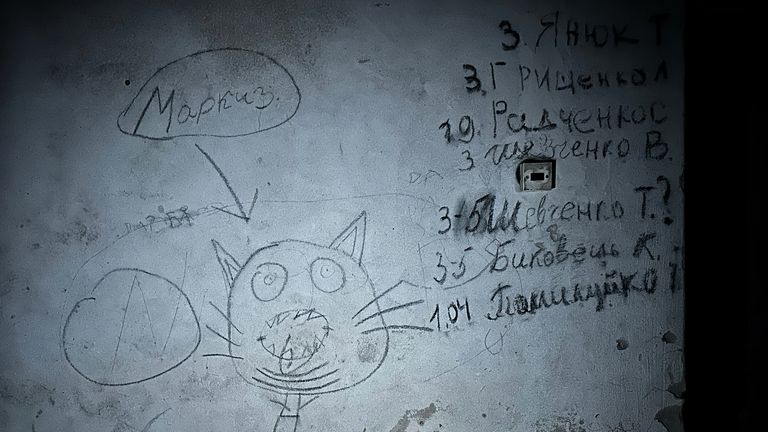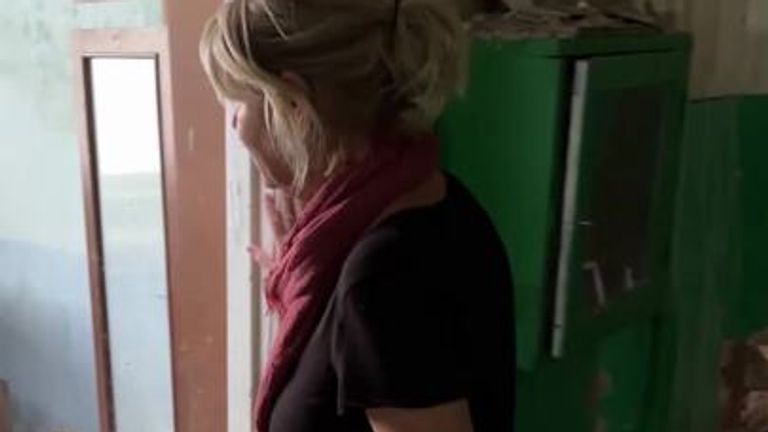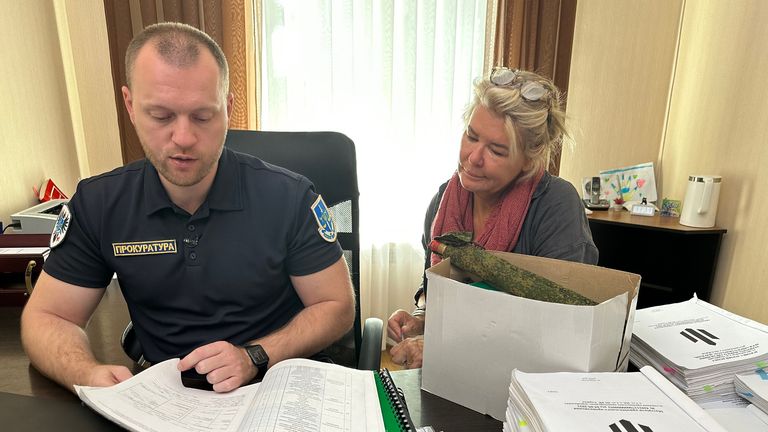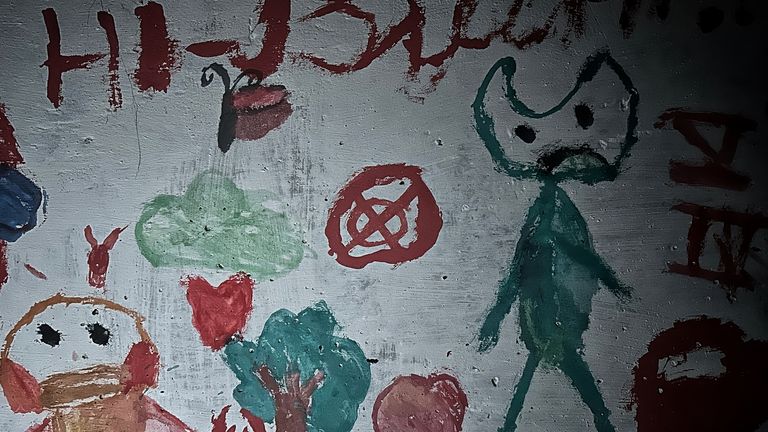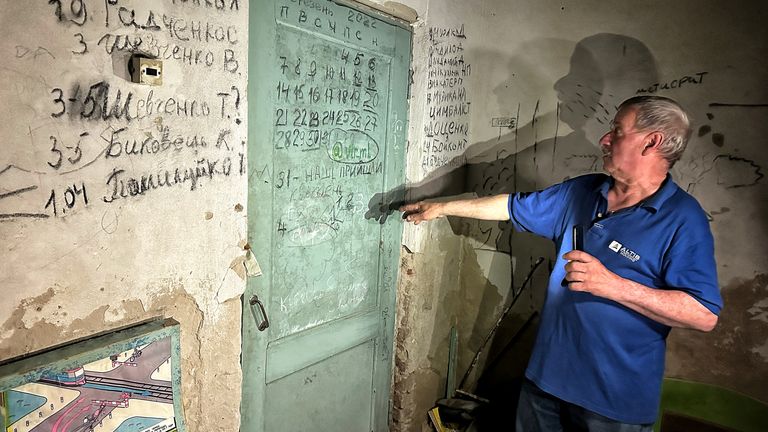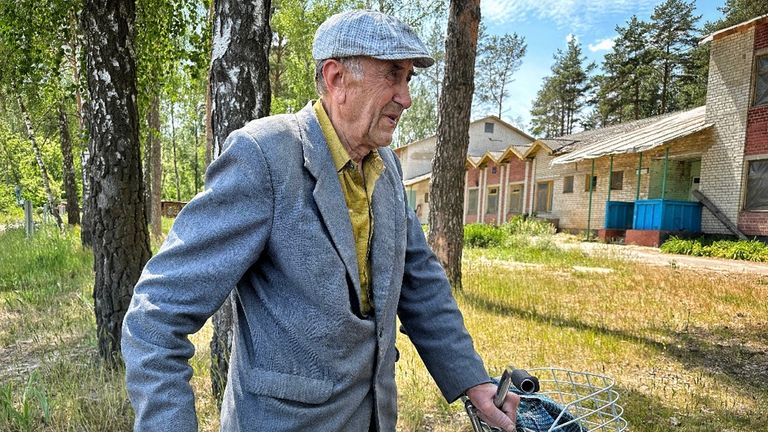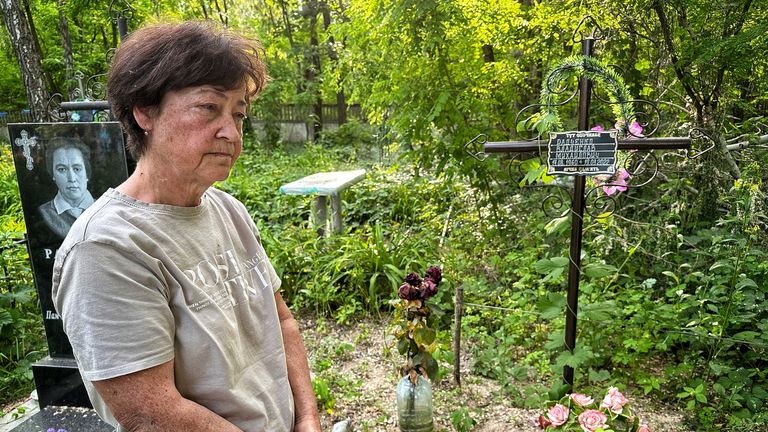Surrounded by forest, the village of Yahidne in northern Ukraine looks deceptively peaceful.
On a bright, summer’s day, a troupe of singers dressed in national costume perform in the ruins of a bombed-out, community club. Their voices lilt and lift, as their bodies sway. The audience clap, smile and tap their feet.
On the surface, there are little signs of the shared trauma they’ve suffered. But look closer at this joyful scene, and several spectators are weeping. Others hold their heads in their hands.
Kyiv under attack – latest updates on Ukraine war
The memory of “28 days of horror” – when Russian soldiers trapped almost the entire population in a school basement – is still raw.
In the middle of their performance, the singers fall silent, their heads bowed to honour those who lost their lives when the Russians took over the village.
“We went in as children and came out as adults. Your values change when you can’t eat, sleep or go for a shower,” says 16-year-old Marina, one of the singers. “It’s hard to forget and hard to remember.”
Back in late February 2022, in the violent first month of war, almost the entire village – with a population of around 400 before the Russian invasion – was held captive below ground in dark, freezing temperatures with little electricity.
They were starved of food and water, tormented and tortured by their kidnappers. Ten of them died in captivity, while others spoke of enduring humiliating and brutal conditions where disease and fear ran rampant.
Now more than a year after their ordeal, these villagers are about to be the star witnesses in Ukraine‘s biggest war crimes trial to date which will see 15 Russian soldiers go on trial. Prosecutors believe the case is so strong it could end up in the International Criminal Court.
Sky News has been given access to a mass of evidence gathered over more than a year of investigations. Our team has also interviewed more than a dozen survivors and seen the 3D scanners that are being used to recreate the crime scene in forensic detail.
During that time, 368 of the villagers including 69 children were kept in appalling, cramped conditions. The 10 who died during their confinement were mainly elderly people who deteriorated due to the unhygienic conditions and lack of sustenance.
Corpses lay among the living for hours, sometimes days, until the Russians could be persuaded to bury them.
‘They deliberately starved us’
Valentyna Lohrynchuk was among those held captive. “How can I describe something like that?,” she says, with horror in her voice. “One minute we’d be talking to a granny and then next, we’d realise they were dead. They deliberately starved us. They had food but they didn’t give us any.”
Even then when a group of seven was allowed to go to the village cemetery to dig graves for those who had died, within minutes they were shelled from Russian positions.
The village priest, Dimetry Yarema, who was conducting the burial prayers, says: “It was definitely the Russians who shelled us. I feel it was a deliberate tactic to try to kill us or scare us.”
The Ukrainian lawyers will attempt to prove the Russian soldiers violated a string of international laws centring on the treatment of civilians during war time. These include setting up their military base inside a protected building and using the villagers as human shields to stave off attacks by the Ukrainian military who were fighting to reclaim Yahidne.
The 34-year-old prosecutor who has been working non-stop on this case for more than a year is optimistic about the outcome. Serhil Krupko unlocks the safe in his office and shows us some of the vital evidence.
War crimes cases, he explains, rest on multiple factors. “It is necessary to have physical evidence which can prove the individuals were there. As well as witnesses who can identify them.”
The documents Krupo and his team have collected include army files with photographs of the soldiers and all their personal details. He says Ukrainian journalists, who are part of a group called the Reckoning Project, helped gather a stash of evidence.
Some of the journalists tracked down Russian sim cards, traced them to Russia and even interviewed some of the soldiers involved who’d returned there.
Read more:
Ukraine ‘probing Russian defences’
Iran is helping Russia build drone factory, White House says
On top of that, the prosecutors have more than 300 survivors who were also witnesses to the crimes and have been able to identify the Russian soldiers involved, as well as give detailed accounts about what they did and how they behaved.
Villagers unable to stretch or move for 16 hours
In the windowless basement, villagers were kept confined to separate cell-like rooms, which were all so overcrowded that there was no space to lay down. Many spoke about regularly spending 16 hours straight in a single position, unable to stretch or move.
There was limited access to urinate or defecate and they were given buckets to use in the corner of some of the rooms. School teacher, Valentyna Danilova, says she believes it was a deliberate tactic to break them: “They didn’t want us to feel human,” she says. “We had no hygiene – we couldn’t even wash our hands the first 10 days.”
Many of the elderly people were terrified to drink very much, she adds, because they feared going to the toilet with little privacy or worse, being forced to urinate where they sat.
The walls of the basement still have some paintings drawn by the children and maybe some of the adults. We find the words of the Ukrainian anthem as well as hearts coloured in red and the words “no war” inscribed above in big letters.
Perhaps the most poignant image though is of a line of stick figures, stark in the simplicity of the drawing but with some of the figures clearly shooting those next to them in the head.
Occasionally, the soldiers opened the basement door to let them out to go to the toilet behind the main school building but every time they ventured out from the basement, they risked being shelled in the battle over the village.
The Russians told them they had already taken Kyiv and that President Zelenskyy had fled. They even presented their captives with a Russian newspaper detailing this ‘news’ of the Ukrainian collapse.
‘None of us expected to leave alive’
The teacher, Valantyna, managed to smuggle a bit of charred wood into the basement and started a calendar where she chalked off the days and kept a note of the dead – those who were killed as the Russian troops entered the village and another list of those who died while being held in the underground school rooms.
With so little light, they struggled to differentiate between day or night.
“None of us expected to leave alive,” Valantyna says, “and there was an understanding among us that one day our children would come and find this place and at least they should know who was here and what happened.”
She describes how some of the guards seemed to enjoy tormenting their prisoners. It was freezing cold in the basement, so she asked to collect a blanket for her elderly mother.
“They agreed but the moment I got outside, the soldiers started shooting at my feet. I stumbled and they laughed. It was funny to them.”
Several villagers were killed before making it into the basement. Mykhailo Shevchenko said his son Viktor was one of the first killed as the Russian troops entered Yahidne.
His death will be investigated too after post-mortems appeared to show he was tied up and tortured before being shot in the head. His body then lay in the garden of his home for more than two weeks.
“Seventeen days he was lying there barefoot and his hands were tied behind his back,” says Mykhailo.
The villagers’ hopes have been raised by the guilty verdicts handed out to soldiers involved in terrorising local resident Nadiia Radchenko’s family.
Her husband was killed, her house looted and guns put to their heads. Ukrainian lawmakers sentenced three Russian soldiers to 12 years in prison in absentia.
“It’s good to get a verdict,” Nadiia says, “but not good they’re still walking free because everyone needs to be held accountable and if you deliberately came to attack us, you need to be punished.”
Serhil Krupko, the Ukrainian prosecutor, emphasised to us how important he thinks this case is. “We believe his case will show how the Russians were using ordinary civilians as human shields,” he says. “And our international criminal court partners were very interested in this.”


